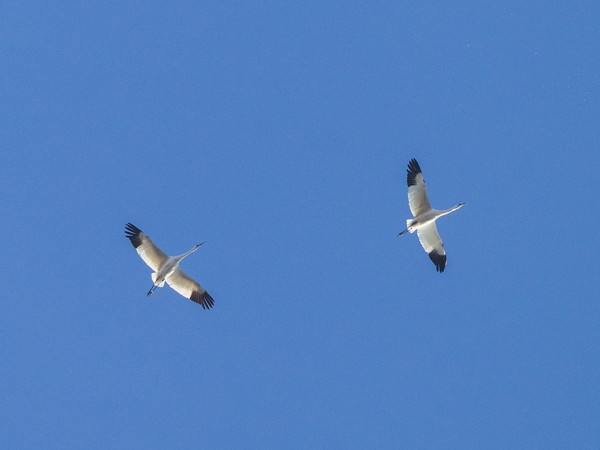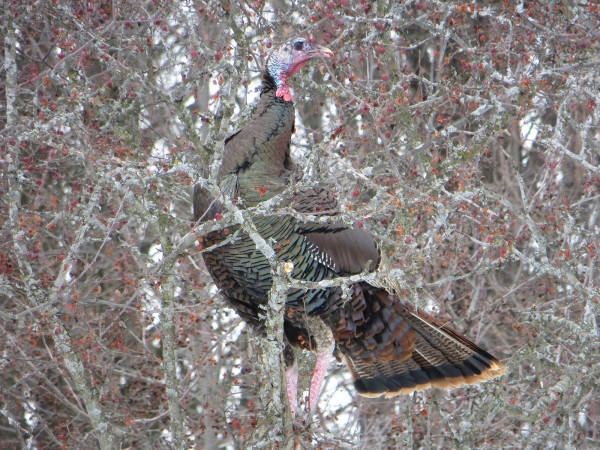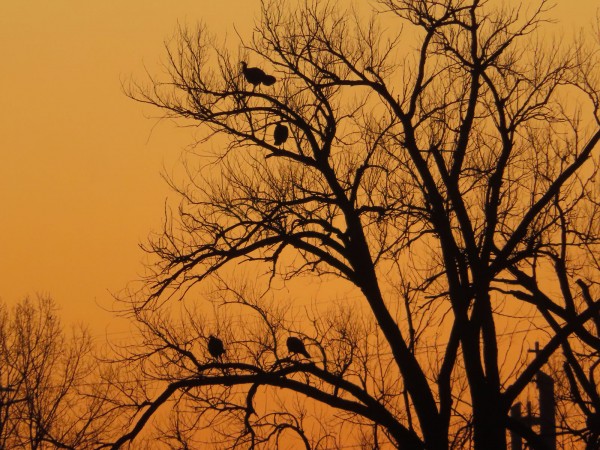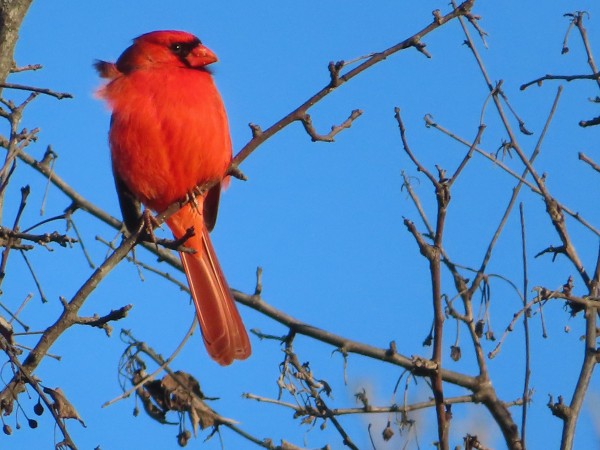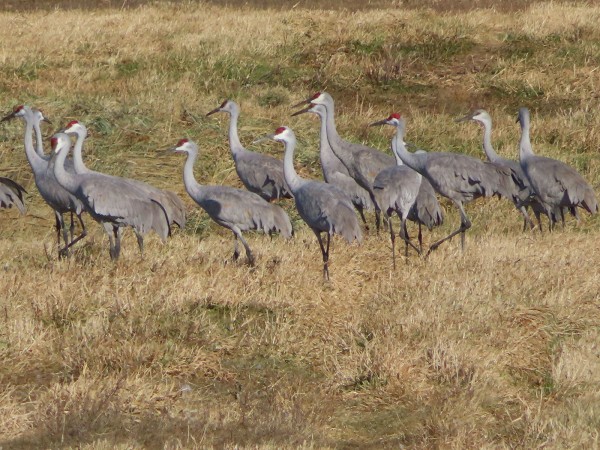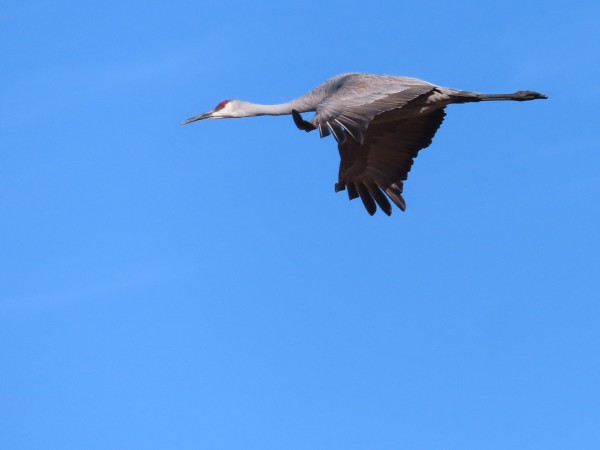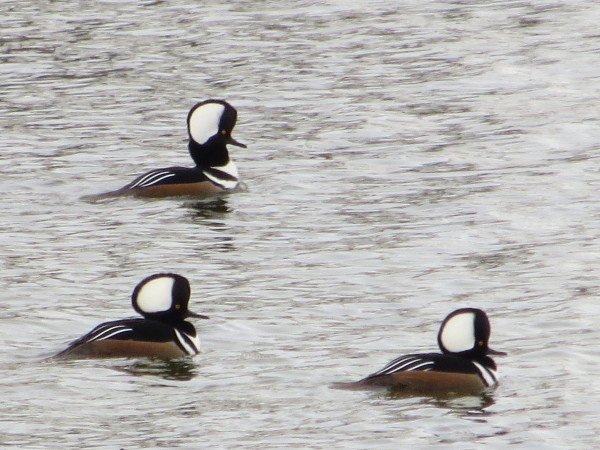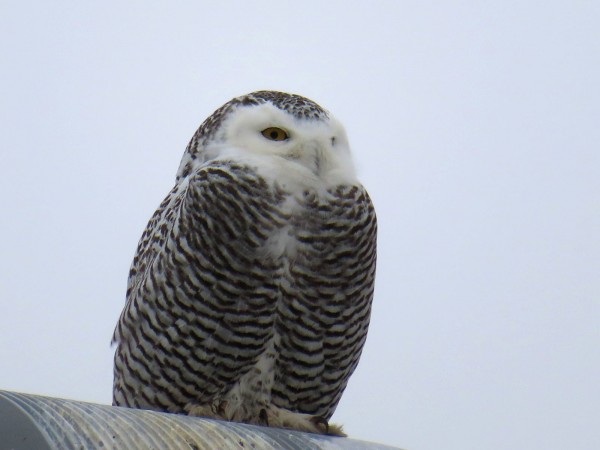Chuck's Birding Report #90
30 November - 06 December 2021
Dear fellow flock of birders,
The answer to last week’s ID question of the 2 birds flying with the Sandhill Cranes is Whooping Cranes. Included is a photo of just the two Whooping Cranes. They are larger than Sandhill Cranes and are mostly white with black tips on their wings. Both photos were taken by Kenny Younger.
We are now moving into winter birding in the Arb. What I see in the winter are American Robins, European Starlings and Wild Turkeys feeding in the Crabapple Collection. There are also occasional Cedar Waxwings, House Finches, American Goldfinches and Black-capped Chickadees there too. The American Goldfinches are more often at the Whitespire and Sweet Birches just south of the Crabapple Collection eating seeds from the female catkins. Included is a photo of a Wild Turkey up in a Crabapple Tree feasting on crabapples.
Wild Turkeys perch in trees overnight to be safe from predators like coyotes. I often see them in the white pines northeast of the Visitor Center. Last Tuesday when we arrived at the Visitor Center we could see 4 Wild Turkeys in a large leafless tree down by Pond 2. They were really high. I don’t think I’ve ever seen them that high in a tree. A photo of the Wild Turkeys in the tree is included. The sun was rising so it cast a golden color to the photo.
There are Mallards at the Big Spring where the water stays open all winter. On occasion another duck species can be seen too. One or two Great Blue Herons stay all winter while all of their fellow herons head south for the winter. The herons that stay go from one spring to another around Lake Wingra. The one seen at Big Spring usually stands in the water either on the left side at the end of the outflow of the spring. On really cold days it looks pretty pathetic hunched over in the cold. It feeds on small fish in the open water.
More of the birds are at the periphery of the Arboretum obtaining their food from feeders at homes at the edge of the Arboretum. Food is more difficult to find in the Arboretum in the winter so why not go to home feeders where food is so easy to obtain. Many birds are found at the Spring Trail Pond (aka the duck pond). This part of the Arboretum in found on Nakoma Dr. just before it joins Monroe St. There is a small parking lot there holding about 6-7 cars. There is also a spring there that feeds the pond keeping the water open all winter. There can be 50-100 Mallards on the pond all winter. They get water and can bathe there. For food they fly slightly over the cars and road, land on the sidewalk and waddle up the street to turn right into the backyard of a home owner who feeds all kinds of birds. When full the ducks fly back to the pond. All sorts of other birds take advantage of the food put out by this home owner too. In addition some of the birds who normally fly south might stay for the food and water too. Birders often see Fox Sparrows and White-throated Sparrows. Last year we even had a Spotted Towhee, a western bird, visit for a month or two. So the Spring Trail Pond is the place to bird in the winter.
The winter birds like the Dark-eyed Juncos and American Tree Sparrows will often feed along the edges of the roads in the Arboretum. There are usually other winter birds too like Pine Siskins and Common Redpolls. A couple Common Redpolls have been seen at Icke Boardwalk but I have not seen any redpolls or Pine Siskins yet. The siskins and redpolls feed on the seeds of the female catkins in the birches and European Alders. Another two winter birds that we saw last year were Red Crossbills and White-winged Crossbills feeding on the seed of pine cones in the spruces in the Pinetum. They normally live in the far north but will come south if natural food sources are scarce up north.
On last Tuesday’s walk my group got good views of both a male and a female Northern Cardinal in the open perched in a tree in full sun. One of the birders said I needed get photos of them and so I did. Photos of both are included.
We still see a Red-tailed Hawk or two in the winter. The Barred Owl sometimes perches in a Juniper on Juniper Knoll.
My last four photos were not taken in the Arboretum but could have and I can make up stories that can connect them to the Arboretum.
Let’s start with two photos of Sandhill Cranes. The two photos were taken at Nine Springs. Sandhill Cranes gather there in the 100s before they take off for points farther south and east. The other day when I visited Nine Springs I saw and counted 210 Sandhill Cranes primarily in the northeast part of Nine Springs. My first photo shows a group of Sandhill Cranes all facing west. The wind was blowing so hard they had to face into the wind to stay upright. Notice they are all in their new fall gray plumage. If you look at the 2 cranes at the far right without red crowns I think those are the colts of our family from the Arboretum’s Curtis Prairie. The next 2 to the left of the colts with red crowns are the colts’ parents. So our family from the Arb is complete. A little later I captured a flying Sandhill Crane and that one for sure is the male parent of our family of Sandhill Cranes. You just tell by the beauty of its flight.
The next photo is one of three male Hooded Mergansers. They have impressive black and white raised hoods or crests. They can make all kinds of moves with their heads and hoods. I saw about 24 Hooded Mergansers plus many other duck species at Turville Bay. If you want to see lots of different waterfowl this time of year, head to Turville Bay and University Bay.
My last photo is of a bird that we look forward to see each winter. It can be difficult to find and some winters they don’t even come down south this far. The bird is a SNOWY OWL!!! This bird is born way up north on the treeless tundra. They can be all white if an adult male or white with numerous black spots or short bars if female or immature. They are most often seen on the ground in farm fields and must be distinguished from white plastic bags. I’ve seen a lot of white plastic bags in fields. They can be perched on fence posts, light posts or sometimes barns. On Saturday a birder we all know well texted a few of us that one had been seen on a light post in the median between the two lanes of John Nolan Drive. What!! That’s not a farm field!! Anyway some of us went to look for it and sure enough it was high on a street light in the middle of very heavy traffic. It’s a perfect replica of the northern tundra, right? Not!! Evidently this adventurous Snowy Owl wanted to see what the Big City was like. Luckily for a few of us it stayed up on the light long enough that we could take some photos. At one point a car on John Nolan slowed way down and honked its horn. The Snowy took off and flew west. It landed on a sign along the railroad tracks and finally flew farther west and out of sight. We were so lucky to see it. We thank the Snowy Owl for letting us see and photograph it and to the birder who located it for us. That sighting really made our day!
That’s the bird report for the past week.
I wish you all good health and good birding too,
Chuck

